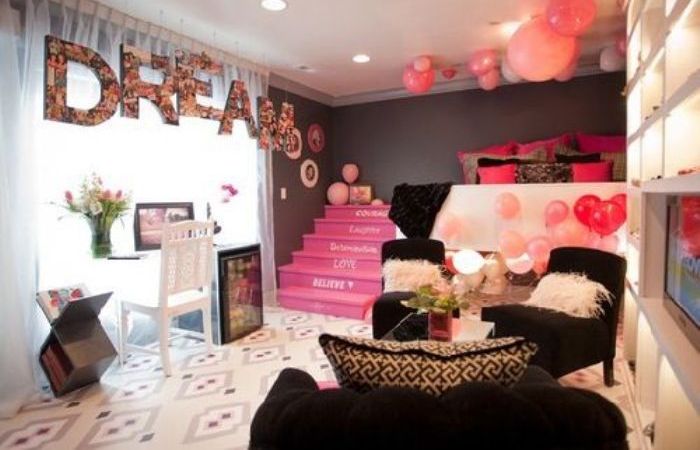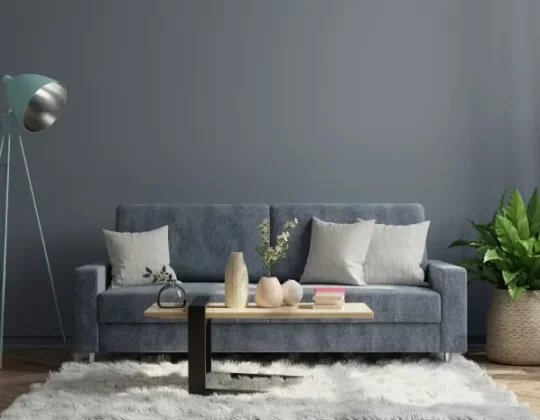Decorating a small living room can be challenging, but it’s also an opportunity to get creative. While you may need to think more carefully about how to make the most of the space you have, the end result can be a cozy, comfortable area that serves all your needs.
However, a small living room can also be seen as an opportunity to get creative and use innovative solutions to maximize space. The following Small Living Room Ideas will guide you on how to transform your limited space into a stylish, functional, and reflective of your personal style.
Small Living Room Ideas: Making the Most of Your Space
1. Sneak in Storage

One of the biggest challenges in a small living room is finding space for storage. One way to do this is to incorporate furniture pieces that double as storage. A coffee table with hidden storage, a TV stand with shelves, or a sofa with built-in drawers can help keep clutter at bay.
Shelving, whether freestanding or built-in, is another excellent option for storing books, decor items, and more. Vertical storage solutions, like tall bookcases or mounted wall shelves, can make use of unused wall space and draw the eye upwards, creating an illusion of height.
2. Focal Point

Even in a small living room, creating a focal point can help define the space and make it feel more organized. This could be a large piece of artwork, a feature wall, a fireplace, or even a statement piece of furniture. By drawing the eye to one main point, you can create a sense of order and balance in the room. Keep other elements in the room more subdued to ensure your focal point stands out.
3. Utilize Living Room Furniture

Choosing the right furniture can make all the difference in a small living room. Opt for pieces that are proportionate to the room’s size. Consider multifunctional furniture, like a sofa bed or a nesting coffee table. When space is limited, pieces that can serve multiple purposes can help maximize your living room’s functionality.
In terms of upholstery, opt for lighter colors or neutrals as these can help to open up the space. If you’re keen on patterns, keep them small-scale to avoid overwhelming the room.
4. Arrange Furniture Efficiently

The way you arrange your furniture can greatly impact how spacious your living room feels. Try to avoid blocking pathways with furniture and consider how people will move around the space. Placing a piece of furniture at an angle, or against the longest wall, can help to streamline the room and create a sense of spaciousness. Also, remember that not every corner needs to be filled; leaving some empty space can make the room feel bigger.
5. Add Personal Style

In a small living room, adding your personal touch can make the space feel cozy and inviting. Your personal style might be reflected in the color palette you choose, the furniture styles you prefer, or the accessories that adorn your room. Displaying items that hold sentimental value, like family photos or travel souvenirs, can give your living room a unique and personal touch.
6. Walls Pop with Art

Art can have a transformative effect in a small living room, serving as a focal point and sparking conversation. A large-scale piece can create a sense of drama, while a gallery wall can showcase your personal taste and interests. Remember to hang art at eye level for optimal viewing and to ensure the room feels balanced.
7. Install Smart Lighting

Lighting plays a crucial role in creating a sense of space. In a small living room, it’s important to have a layered lighting plan. Ambient lighting, like ceiling fixtures or recessed lights, provides overall illumination. Task lighting, such as table lamps or reading lamps, is useful for activities like reading or working. Accent lighting, like picture lights or wall sconces, can highlight art or architectural features.
8. Double-Duty Furniture

In a small living room, furniture that serves multiple functions can be a game-changer. Consider a coffee table with storage or an ottoman that doubles as a seat and a storage bin. A sofa bed can provide a place for guests to sleep, and nesting side tables can offer extra surface area when needed, but tuck away neatly when not in use.
9. Minimize Visual Weight

In small spaces, minimizing visual weight can help a room feel more spacious. Choose furniture with exposed legs, use glass or lucite pieces to maintain an open feel, and opt for pieces that are proportional to the room’s size. Light colors and reflective surfaces can also help to bounce light around the room and create a sense of spaciousness.
10. Soft Background

In a small living room, creating a soft, light background can help to open up the space and make it appear larger. Consider painting your walls in light shades like white, cream, or soft pastel hues. These colors reflect light and can help make the room feel more airy and spacious. You can add pops of color through your furniture and accessories to ensure the space still has plenty of personality and interest.
11. Character to Walls

Just because your living room is small doesn’t mean it can’t be big on style. Adding character to your walls can elevate the design and make the room feel more sophisticated. Consider a stylish wallpaper, a textured wall treatment, or even a gallery wall of your favorite artwork or photographs. Remember to balance these features with more neutral elements to ensure the space doesn’t feel too busy or cluttered.
12. Hang Plants

Plants can add a burst of life and color to your small living room. Hanging plants are particularly useful in small spaces, as they don’t take up any floor space. You could hang a trailing plant from the ceiling, mount a planter on the wall, or place a potted plant on a shelf. Besides adding a touch of nature to your space, plants can also improve air quality and boost your mood.
13. DIY a Barn Door

In a small living room, traditional doors can take up valuable space. A DIY barn door is a stylish and practical solution. Barn doors slide along a track, meaning they take up less space than a swinging door. They also add a rustic, charming touch to your room. You can customize your barn door to fit your style and the size of your space.
14. Space-Expanding Colors

Certain colors can create the illusion of a larger room. Light colors and cool hues, like blues and greens, are known to visually expand a space. You can apply these colors to your walls, choose furniture in these tones, or incorporate them through accessories like rugs and cushions. Remember to balance these space-expanding colors with a few darker or bolder hues to add depth and contrast.
15. Low-Profile Furniture

Choosing low-profile furniture can create an illusion of more space in a small living room. Pieces that sit low to the ground, such as a sleek, modern sofa or a low coffee table, can help make the room feel more open and airy. Additionally, furniture with slender frames and open bases can keep the room from feeling crowded.
16. Strategize With Mirrors

Mirrors are a small space’s best friend. They reflect light and can create the illusion of depth, making your living room appear larger. You can hang a large mirror on a wall, place a floor mirror behind a piece of furniture, or even group several smaller mirrors together for an eye-catching display. Remember to place your mirrors strategically, where they can reflect a window view or bounce light from a pendant lamp.
17. Separate Zones With Lighting

In a small living room that serves multiple functions, use lighting to separate different zones. For example, a table lamp can create a reading nook, pendant lighting can define a dining area, and recessed lighting can illuminate the entire room. This approach not only creates distinct zones within the room but also adds depth and dimension.
18. High Ceilings

If you’re fortunate to have a small living room with high ceilings, use them to your advantage. High ceilings can make even the smallest room feel more spacious. Draw attention to this feature by hanging curtains from the ceiling to the floor, or installing a statement light fixture that draws the eye upward. You can also use vertical shelves or tall pieces of artwork to emphasize the height of the room.
19. Display Artwork

Artwork can add personality and interest to a small living room. Instead of a gallery wall, which might overwhelm a small space, consider displaying one or two larger pieces. This can create a focal point and give your room a more open feel. Make sure the scale of the artwork complements the size of your room and doesn’t overwhelm the space.
20. Use Acrylic Furniture

Acrylic or Lucite furniture is a great solution for small living rooms because these pieces are virtually invisible, making them take up little visual space. Whether it’s an acrylic coffee table or a set of acrylic chairs, these pieces can provide the functionality you need without making the room feel cramped. Plus, they add a modern and trendy touch to your space.
21. Large Rug

While it may seem counterintuitive, a large rug can actually make a small room appear larger. A rug that extends beyond the furniture can create the illusion of more floor space. It also helps define the seating area in your living room, making it feel more intentional and put-together. Choose a rug that complements your color scheme and style for the best impact.
22. Clean Color Scheme

A clean, simple color scheme can make a small living room feel more spacious and serene. This usually means sticking to neutrals or soft, light hues. These colors reflect light and can help to open up the space. While a clean color scheme provides a backdrop, don’t be afraid to add in a few bold or dark accents to give the room character and depth.
23. Layer In Texture

In a small living room, texture is important. Texture adds visual interest and prevents the room from feeling too flat or one-dimensional. This could mean a leather armchair, a knitted throw, a velvet sofa, or a sisal rug. You can also introduce texture through elements like curtains, cushions, and wall hangings.
24. Dark Paint Color

It’s a common misconception that dark colors are a no-no in small spaces. In reality, dark paint colors can add drama and create a perception of depth, which can actually make a small living room seem larger. Whether it’s a deep blue, rich burgundy, or cozy charcoal, a dark color on your walls can create a stylish and intimate space.
25. Be Flexible with Seating

In a small living room, flexible seating options can be a lifesaver. Think poufs, ottomans, or benches that can be moved around easily. These pieces can serve as extra seating when you have guests, but can also function as side tables or footrests on a daily basis.
26. Coffee Table with Storage

A coffee table with built-in storage can be a game changer in a small living room. Not only does it provide a surface for drinks or books, but it can also hide away items like remote controls, magazines, and coasters. Opt for a design with drawers, shelves, or a lift-top to maximize storage space.
27. Build in Shelving

In a small living room, built-in shelving can be a space-saving solution. It uses the vertical space on your walls, leaving more floor space available. You can use these shelves to store books, display decorative items, or even house your TV. Built-ins can give your living room a custom, finished look, and can often add value to your home.
28. Use Unexpected Furniture

In a small space, think outside the box when it comes to furniture. Perhaps a trunk can serve as a coffee table, or a console table can double as a desk. A narrow bookcase behind the sofa could provide storage and a surface for lamps or accessories. Using unexpected furniture can add character and functionality to your living room.
29. Build Banquettes

If your small living room also needs to function as a dining space, consider building a banquette. A built-in bench seat can be more space-efficient than a set of dining chairs, and can provide additional storage underneath. Pair the banquette with a small round table for a cozy dining nook.
30. Low Seating

Low seating, like floor cushions or a low-slung sofa, can make your ceilings appear taller and your living room feel bigger. This can create a laid-back, bohemian vibe in your space. Remember to provide enough support and comfort if you’re opting for floor seating.
Conclusion
In conclusion, small living room design is all about making thoughtful decisions. From smart storage solutions and creating a focal point, utilizing space-expanding colors, selecting the right furniture to using mirrors and lighting strategically, each decision can help to maximize your space and create a living room that feels comfortable, functional, and stylish. With these small ideas, you can create a space that is big on style, no matter its size.








